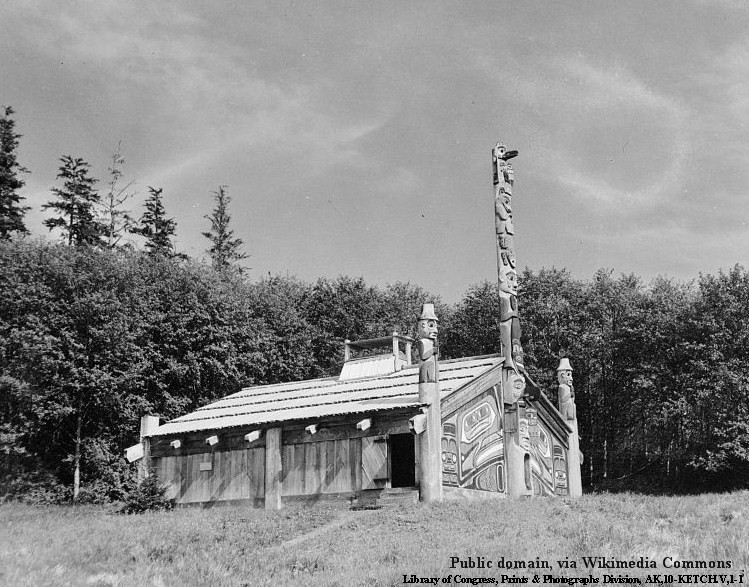KETCHIKAN
Ketchikan is a city in Ketchikan Gateway Borough, Alaska. It is located on the southwest side of Revillagigedo (ruh-vee-uh-guh-Gay-doh) Island, on Tongass Narrows opposite Gravina Island.
It is the first or last port, depending on your route. Being the first city heading north, it is known as Alaska's First City or Gateway City. Situated within a rainforest and averaging 162 inches of rain a year, Ketchikan is known as the Rainfall Capital of the U.S., as well as the Salmon Capital of the world.
History
The name Ketchikan comes from Ketchikan Creek, which flows through the town. It comes from the Tlingit name for the creek Kitsch-Hin, meaning the creek of the "thundering wings of an eagle." The Tlingits used the mouth of the creek as a fish camp.
Four major legal industries, Fishing, Mining, Timber, and Tourism, made Ketchikan what it is today. One not so legal industry, a "red light" district which made up Creek Street, also thrived in the early years. One of the main attractions today, Creek Street offers lots of culture and shopping for cruise ship passengers. It is not a street but a boardwalk overlooking Ketchikan Creek, where thousands of salmon spawn each summer.
The Ketchikan fishing industry started with a saltery owned by a man from Oregon named Snow in the late 1800's. In a saltery, the fish are prepared for market. The process of soaking fish in salt brine or packing them in dry salt, is a cheaper preservation method than canning. A few years after the saltery was established, Mike Martin was sent to Ketchikan to open a cannery. There was already a cannery about 20 miles from Ketchikan creek but Martin thought being closer to the Creek would make a better location. Martin purchased 160 acres from Chief Kyan; that acreage is where the city of Ketchikan is located today.
Mining nearby Prince of Wales gold and copper discoveries briefly brought activity to Ketchikan, with just enough strikes to keep some interested. Charles W. Wright wrote in 1908, Mining In Southeastern Alaska, Ketchikan Mining District, "Little interest has been shown in gold mines and prospects in the Ketchikan district during the year, and except the gold contained in the copper ores the production of this metal was very small."
In response to the need for lumber for packing boxes and new construction, the Spruce Mill was founded in 1903; it operated for over 70 years. Aviation used wood and spruce was one of the best. By World War II spruce became very popular, and Ketchikan played a role in supplying spruce for airplanes construction. The largest is the Spruce Goose, made of spruce, birch, and balsa wood.
Ketchikan Pulp Company was established in 1948 to bring permanent year-round jobs to southeast Alaska. The pulp mill was located on the north shore of Ward COVE. Owned by Louisiana-Pacific, it operated from 1954 to 1997 and was the last pulp mill to operate in Alaska.
Ketchikan is a city in Ketchikan Gateway Borough, Alaska. It is located on the southwest side of Revillagigedo (ruh-vee-uh-guh-Gay-doh) Island, on Tongass Narrows opposite Gravina Island.
It is the first or last port, depending on your route. Being the first city heading north, it is known as Alaska's First City or Gateway City. Situated within a rainforest and averaging 162 inches of rain a year, Ketchikan is known as the Rainfall Capital of the U.S., as well as the Salmon Capital of the world.
History
The name Ketchikan comes from Ketchikan Creek, which flows through the town. It comes from the Tlingit name for the creek Kitsch-Hin, meaning the creek of the "thundering wings of an eagle." The Tlingits used the mouth of the creek as a fish camp.
Four major legal industries, Fishing, Mining, Timber, and Tourism, made Ketchikan what it is today. One not so legal industry, a "red light" district which made up Creek Street, also thrived in the early years. One of the main attractions today, Creek Street offers lots of culture and shopping for cruise ship passengers. It is not a street but a boardwalk overlooking Ketchikan Creek, where thousands of salmon spawn each summer.
The Ketchikan fishing industry started with a saltery owned by a man from Oregon named Snow in the late 1800's. In a saltery, the fish are prepared for market. The process of soaking fish in salt brine or packing them in dry salt, is a cheaper preservation method than canning. A few years after the saltery was established, Mike Martin was sent to Ketchikan to open a cannery. There was already a cannery about 20 miles from Ketchikan creek but Martin thought being closer to the Creek would make a better location. Martin purchased 160 acres from Chief Kyan; that acreage is where the city of Ketchikan is located today.
Mining nearby Prince of Wales gold and copper discoveries briefly brought activity to Ketchikan, with just enough strikes to keep some interested. Charles W. Wright wrote in 1908, Mining In Southeastern Alaska, Ketchikan Mining District, "Little interest has been shown in gold mines and prospects in the Ketchikan district during the year, and except the gold contained in the copper ores the production of this metal was very small."
In response to the need for lumber for packing boxes and new construction, the Spruce Mill was founded in 1903; it operated for over 70 years. Aviation used wood and spruce was one of the best. By World War II spruce became very popular, and Ketchikan played a role in supplying spruce for airplanes construction. The largest is the Spruce Goose, made of spruce, birch, and balsa wood.
Ketchikan Pulp Company was established in 1948 to bring permanent year-round jobs to southeast Alaska. The pulp mill was located on the north shore of Ward COVE. Owned by Louisiana-Pacific, it operated from 1954 to 1997 and was the last pulp mill to operate in Alaska.
